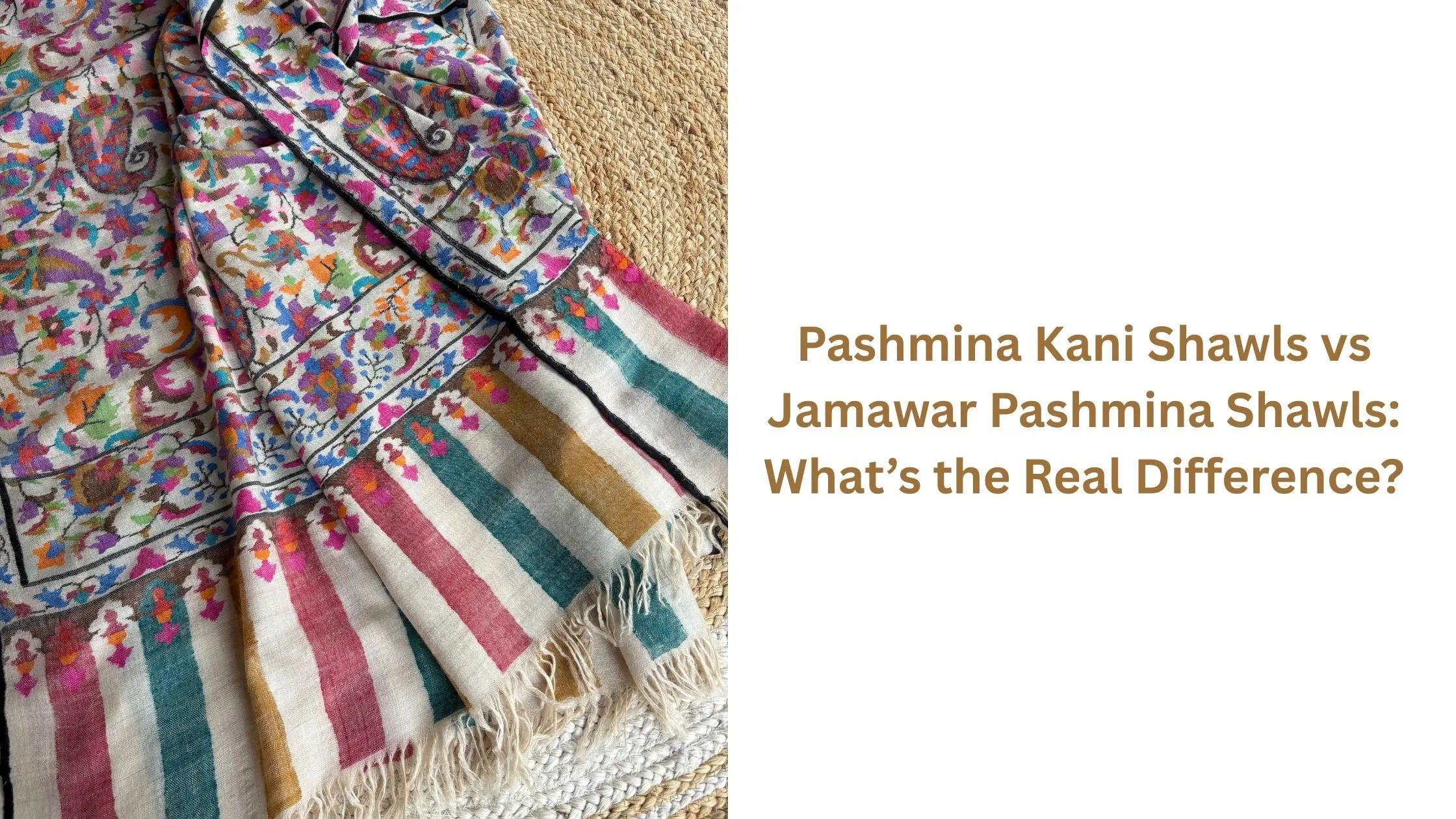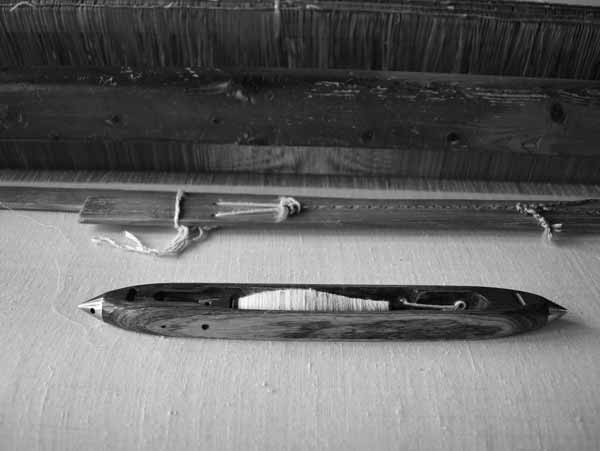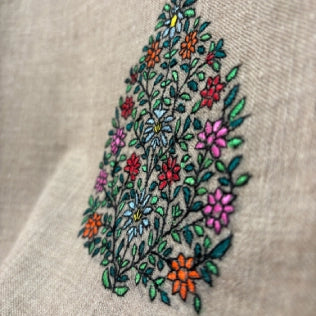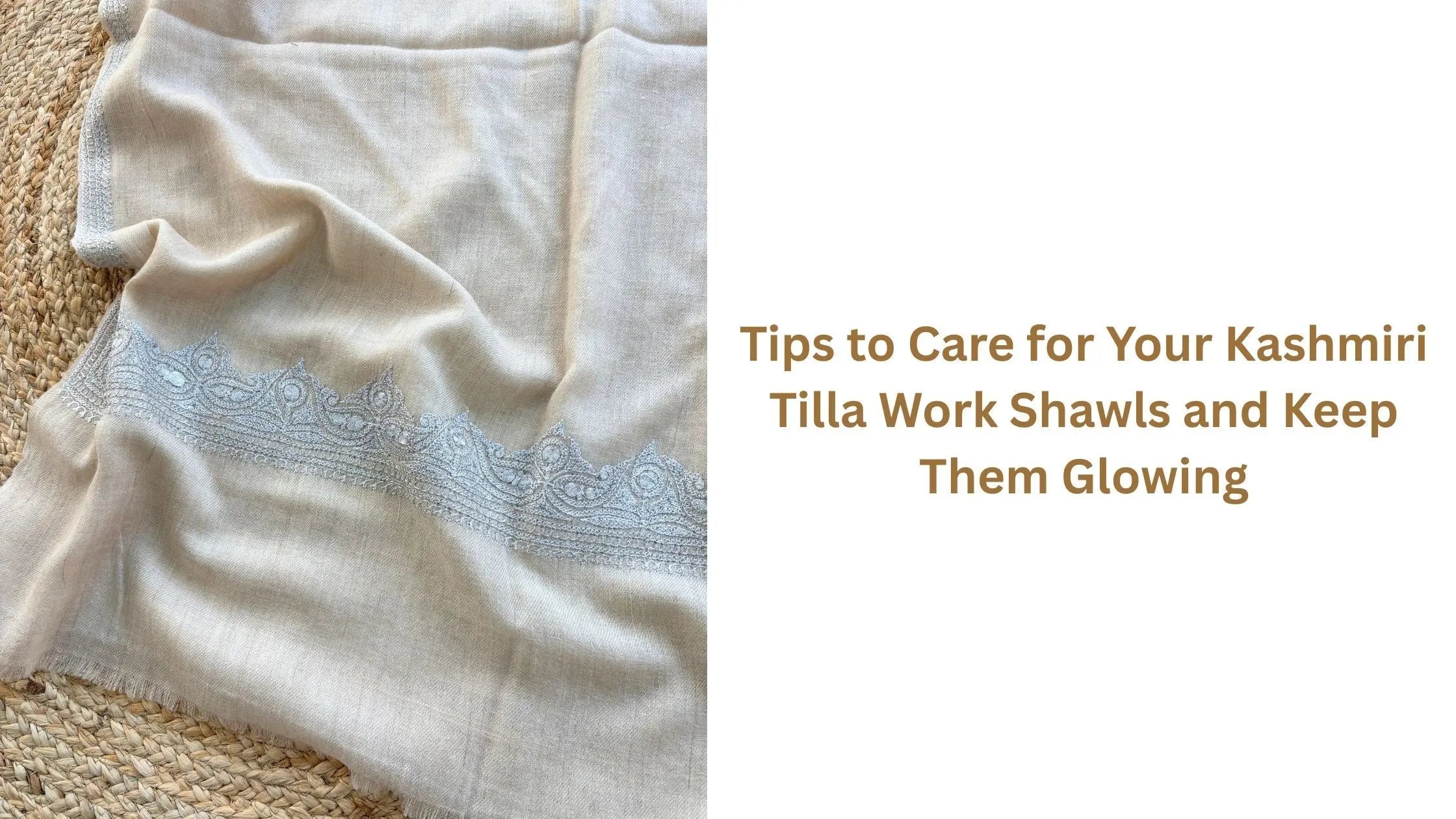
Pashmina Kani Shawls vs Jamawar Pashmina Shawls: What’s the Real Difference?
When it comes to luxury shawls, two names stand out—kani shawls of Kashmir and jamawar pashmina shawls. Both have deep roots in Kashmiri tradition, but they look and feel very different. If you’ve ever found yourself stuck between a Kashmiri pashmina kani shawl and a jamawar piece, this blog will help you understand the real differences.
These aren’t just winter wraps—they carry stories of centuries-old weaving methods, skilled hands, and cultural pride. Let’s dive into how these two types of shawls stand apart and what makes each one special.
What Is a Kani Pashmina Shawl?
A kani shawl is one of the oldest forms of handwoven shawls made in Kashmir. The term "kani" comes from the wooden sticks or bobbins used in weaving. These sticks replace the traditional shuttle and allow the artisan to weave complex designs directly into the fabric.
-
Patterns are woven directly, not stitched
-
It takes 3–12 months to finish one shawl
-
Usually made with pure pashmina wool
-
Made using small wooden bobbins called kanis
-
Famous for their vibrant colors and intricate motifs
How Are Kani Shawls Made?
The process of making kani shawls is slow but deeply skilled. Each weaver follows a written pattern, known as a Talim, which guides the entire design. This tradition has been passed down for generations in Kashmiri families.
-
Weavers follow a coded design chart (Talim)
-
Each color is added with a separate bobbin
-
Can take up to a year for a detailed piece
-
Usually made by master artisans in Kashmir
-
No two shawls are exactly the same
What Is a Jamawar Shawl?
There’s often confusion about jamawar shawls, but the term refers not to a technique like embroidery or weaving—but to the design style. The word “Jamawar” comes from Persian: jama (robe) and war (yard), and it traditionally describes shawls with elaborate all-over patterns.
-
Known for rich, all-over decorative patterns
-
Can be either woven (Kani Jamawar) or embroidered
-
Often use floral or paisley motifs
-
Silk threads may be added for shine
-
Heavier and more ornate than simpler shawl styles
Key Differences Between Kani and Jamawar Shawls
Both shawls are handcrafted and luxurious, but they differ in design approach, look, and use case.
Design Technique
-
Kani shawls are made using a traditional weaving method where patterns are created on the loom using wooden bobbins.
-
Jamawar shawls refer to pieces that have all-over, intricate designs—these can be woven like in a Kani Jamawar or heavily embroidered.
Pattern Style
-
Kani shawls often feature detailed but placed designs that may not cover the entire surface.
-
Jamawar shawls are known for full-body coverage with elaborate motifs, either woven or stitched.
Weight and Texture
-
Kani shawls are typically lighter and softer due to pure pashmina and the nature of weaving.
-
Jamawar shawls feel heavier, especially when embroidered or fully covered in pattern.
Crafting Time
-
Kani shawls take longer to produce—some even require up to a year depending on the complexity.
-
Jamawar shawls, whether woven or embroidered, also take time but may vary based on design density and method.
Occasion and Usage
-
Kani shawls are versatile—ideal for daily elegance, mild winter use, or formal events.
-
Jamawar shawls are more festive, suited for weddings, grand functions, or traditional celebrations.
How to Identify a Real Pashmina Kani Shawl
With so many fake pashmina items on the market, it helps to know what makes a kani pashmina shawl authentic. A genuine piece is handwoven, often with pure pashmina wool, and shows no embroidery threads or stitching on the reverse.
-
Design appears on both sides of the shawl
-
No loose threads or back-stitching
-
Texture is buttery soft, not scratchy
-
Often comes with Certificate of Authenticity.
-
High cost reflects genuine craftsmanship
When Should You Choose a Kani Shawl?
A kani pashmina is ideal if you want a piece of wearable art that feels light and timeless. It suits both everyday elegance and special occasions without overwhelming your look.
-
Perfect for gifting heritage lovers
-
Suitable for mild to cold weather
-
Pairs well with ethnic or Western outfits
-
Excellent for collectors of rare textiles
-
Provides subtle beauty and charm
When Should You Choose a Jamawar Pashmina Shawl?
Jamawar pashmina shawls, whether woven (like a kani jamawar) or embroidered, are bold and opulent. They’re meant for when you want to make a statement, especially at weddings, festivals, or formal gatherings.
-
Best for special events and celebrations
-
Matches beautifully with sarees, lehengas, and gowns
-
Adds both warmth and a layer of artistic luxury
-
Popular as wedding or festive gifts
-
Great for those who love standout fashion
Price Comparison: Which One Costs More?
Prices vary depending on material, labour, and detail level. Generally:
-
Pure kani pashmina shawls (especially with all-over work) tend to cost more due to the time and skill involved.
-
Jamawar shawls also command high prices if handmade. Machine-made embroidered versions are more affordable but lack the depth and value of artisan-made pieces.
Key cost factors:
-
Pure pashmina = higher base price
-
Kani Jamawar = even more due to complexity
-
Embroidered Jamawar varies based on thread type and coverage
-
Vintage or certified items = highest price range
Which Shawl Is Right for You?
Choosing between a kani shawl and a jamawar shawl depends on your style and purpose:
-
Pick a kani shawl if you want wearable, artistic finesse with historic roots
-
Pick a jamawar pashmina shawl if you’re after grand style, full-body design, and statement dressing
-
Love both looks? Go for a Kani Jamawar shawl—you’ll get the best of both worlds
There’s no wrong choice—just what suits your wardrobe, climate, and taste.
Final Thoughts
Kani shawls of Kashmir and jamawar shawls are both expressions of Kashmiri artistry, each telling its own story. Whether you choose a delicately woven kashmiri kani shawl or an elaborately decorated jamawar, you’re carrying a piece of living tradition.
For those who appreciate heritage, beauty, and craftsmanship, authentic shawls from trusted creators like Shahkaar offer timeless elegance and a connection to Kashmir’s artistic soul.





Leave a comment
This site is protected by hCaptcha and the hCaptcha Privacy Policy and Terms of Service apply.